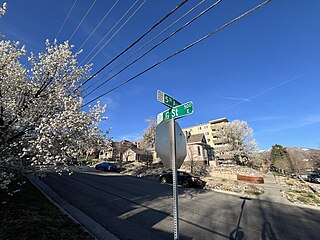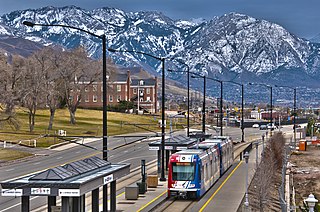
Salt Lake City, often shortened to Salt Lake or SLC, is the capital and most populous city of the U.S. state of Utah. It is the county seat of Salt Lake County, the most populous county in the state. The city is the core of the Salt Lake City Metropolitan Statistical Area (MSA), which had a population of 1,257,936 at the 2020 census. Salt Lake City is further situated within a larger metropolis known as the Salt Lake City–Ogden–Provo Combined Statistical Area, a corridor of contiguous urban and suburban development stretched along a 120-mile (190 km) segment of the Wasatch Front, comprising a population of 2,746,164, making it the 22nd largest in the nation. With a population of 200,133 in 2020, it is the 117th most populous city in the United States. It is also the central core of the larger of only two major urban areas located within the Great Basin.

South Salt Lake is a city in Salt Lake County, Utah, United States and is part of the Salt Lake City Metropolitan Statistical Area. The population was 23,617 at the 2010 census.

The Avenues is an affluent neighborhood in Salt Lake City, Utah. It is named after the perfectly gridlike, closely laid out roads called Avenues and Streets. First surveyed in the 1850s, the Avenues became Salt Lake City's first neighborhood. Today, the Avenues neighborhood is generally considered younger, more progressive, and somewhat "artsy" when compared to other neighborhoods. Many young professionals choose to live there due to the culture and easy commute to downtown.. It is also one of the most important strongholds of the Utah Democratic Party.

Sugar House is a neighborhood in Salt Lake City, Utah. The name is officially two words, although it is often colloquially written as "Sugarhouse." As a primary commercial and residential hub of the region, it is often referred to as Salt Lake's "Second Downtown." Once a primarily residential area with a suburban-style retail hub, the neighborhood has transformed in recent years as mid-rise offices, residential blocks, and hotels have been constructed in the vicinity of Sugar House Park.

Salt Lake City, Utah has many historic and notable sites within its immediate borders. Although the entire Salt Lake City metropolitan area is often referred to as "Salt Lake City", this article is concerned only with the buildings and sites within the official city limits of Salt Lake City.
Rose Park is a neighborhood located in the northwest area of Salt Lake City, Utah, and is among the most ethnically diverse areas in Utah. Its name comes from the area's original developer, who arranged part of the area's streets in the shape of several roses, with one of its main streets, American Beauty Drive, acting as a long rose stem. This area's original roof shingles were red or green and its street names all feature rose varieties. Rose Park residents enjoy a very short commute to downtown, high bikeability, and many recreational amenities.

The Utah Pride Festival is a festival held in downtown Salt Lake City in June celebrating Utah's diversity and gay, lesbian, bisexual, and transgender (LGBT) community. The event is a program of the Utah Pride Center, and includes the state's second-largest parade, after the Days of '47 Parade.

State Route 68 (SR-68) is a state highway in the U.S. state of Utah. It is a major thoroughfare throughout the Wasatch Front as it runs north–south for 70.8 miles (113.9 km), linking US-6 near Elberta to US-89 in Woods Cross. The route intersects several major freeways and highways in the Salt Lake City metropolitan area including I-215, I-80, and I-15. The route is more commonly referred to as Redwood Road, after the street it is routed along throughout Salt Lake County. The highway is also routed for a short distance along 500 South and 200 West in Bountiful and Camp Williams Road in Utah County. The route is a surface street for its entire length.

State Route 186 (SR-186) is a state highway entirely within Salt Lake City, capital of the U.S. state of Utah. It forms a quarter-beltway connecting US-89 and I-15 leading north from Salt Lake City to I-80 leading east; as such, it effectively forms the missing (non-freeway) quarter of the I-215 belt route around the city, though it does not directly connect to I-215 at the north end. Despite this beltway role, the route passes through downtown Salt Lake City because downtown is built right up to the northern mountains surrounding City Creek Canyon. The portion of the route connecting downtown to I-80 is a high-capacity street heavily used by commuters, especially those travelling to the University of Utah or between downtown and eastern neighborhoods, but the portion on Capitol Hill north of downtown is much narrower and has sharp turns around the Capitol grounds. The roadway runs 9.34 miles (15.03 km) along Victory Road, Columbus Street, 300 North, State Street, 400 South, 500 South, and Foothill Drive.

State Route 71 (SR-71) is a state highway completely within the Salt Lake City metropolitan area in the northern portion of the US state of Utah. It runs from SR-154 in the southwest side of the city to SR-186 in Downtown Salt Lake City. The route spans 22.47 miles (36.16 km) as it runs along portions of 12600 South, 12300 South, 900 East, and 700 East streets.

The Red Line is a light rail line on the TRAX system in the Salt Lake Valley of Utah operated by the Utah Transit Authority (UTA). It originally began operation in December 2001 as the peak-hour-only Sandy/University Line, running from the University of Utah south to Sandy Civic Center on the Blue Line. It was later rerouted to South Jordan and renamed the Red Line in August 2011, running as an all-day route. The current line runs from the University of Utah Medical Center in Salt Lake City through the south end of Downtown Salt Lake City, South Salt Lake, Murray, Midvale, West Jordan, and South Jordan to the University of Utah's South Jordan Medical Center in Daybreak.

900 South is a light rail station in Downtown Salt Lake City, Utah, in the United States, served by all three lines of Utah Transit Authority's TRAX light rail system. The Blue Line provides service from Downtown Salt Lake City to Draper. The Red Line provides service from the University of Utah to the Daybreak community of South Jordan. The Green Line provides service from the Salt Lake City International Airport to West Valley City. The station opened on September 19, 2005, and is operated by the Utah Transit Authority. 900 South is notable for being the first infill station constructed along an existing line of the TRAX system.

The Gold Coast Historic District is a historic district in Chicago, Illinois. Part of Chicago's Near North Side community area, it is roughly bounded by North Avenue, Lake Shore Drive, Oak Street, and Clark Street.

Springville is a city in Utah County, Utah, United States, that is part of the Provo–Orem metropolitan area. The population was 35,268 in 2020, according to the United States Census. Springville is a bedroom community for commuters who work in the Provo-Orem and Salt Lake City metropolitan areas. Other neighboring cities include Spanish Fork and Mapleton. Springville has the nickname of "Art City" or "Hobble Creek".
State Street is a wide 17.3-mile-long (27.8 km) street in Salt Lake County, Utah leading almost straight south from the steps of the Utah State Capitol Building, through Salt Lake City, South Salt Lake, Millcreek, Murray, eastern Midvale, Sandy, and northwestern Draper. Because it follows the most direct route from downtown Salt Lake City to the Point of the Mountain pass to Utah County, it was the undisputed main road south from Salt Lake City until Interstate 15 (I-15) was built to the west. It retains the U.S. Highway 89 designation for all but the northernmost seven blocks despite I-15's proximity. Due to its history as a route for long-distance travel, travel within the Wasatch Front region, and travel between the cities along the east side of the Jordan River, it has attracted a wide variety of retail and service businesses along its entire length, creating a nearly continuous commercial axis for the Salt Lake Valley.

Utah State Route 176 was a state highway in entirely within the cities of Salt Lake City and South Salt Lake in Salt Lake County, Utah, United States. It mainly functioned as an alternate route for US-89, US-91, and I-15 traffic that provided access to industrial areas of the two cities and avoided urban cross-traffic in Downtown Salt Lake City. The original route followed 900 South west from State Street to 300 West and then traveled north on 300 West to meet US-89 and US-91 again at South Temple. The route was subsequently changed to follow 300 West only: it followed 300 West all the way from 3300 South (SR-171) to North Temple.

Utah Valley Express, also known as UVX, is a bus rapid transit (BRT) line in central Utah County, Utah, United States. The line is operated by the Utah Transit Authority (UTA) and runs between southwest Orem to south central Provo by way of Utah Valley University (UVU) and Brigham Young University (BYU). It began service with a soft opening on August 13, 2018, while the station platforms were being finished and was formally opened on January 9, 2019. It is the second of several BRT lines that UTA has or is planning in Utah County and the Salt Lake Valley.

Yalecrest is an affluent residential neighborhood located on the East Bench of Salt Lake City and is known for the architectural variety and rare collection of turn-of-the-century homes – all within a six block radius bordered by the South Side of Sunnyside Avenue, North Side of 1300 South, East Side of 1300 East and West Side of 1900 East. Yalecrest is commonly referred to as the "Harvard-Yale area" and several streets are named after Ivy League universities. It is a remarkably visually cohesive area with uniform setbacks, historic houses of the same era with comparable massing and landscaping, as well as streets lined with mature shade trees, and a surprising level of contributing structures that retain their historic integrity. Yalecrest contains 1,487 homes that were built in the early 20th century starting as early as 1912 with the vast majority (74%) built during the period of 1920–1940. The remaining homes in the easternmost part of the neighborhood were built during the post war boom. Yalecrest has the largest concentration of period revival English Cottages, English Tudors, French Norman and Spanish Colonial homes anywhere in Utah. These houses exhibit a variety of period revival styles with the largest portion being English Tudor and English Cottage. According to the Salt Lake City Planning Department, the architectural variety and concentration of period cottages found in Yalecrest are "unrivalled in the state." Examples from Yalecrest are used to illustrate period revival cottages styles in the only statewide architectural style manual. There are 22 subdivisions which were platted and built by the prominent architects and developers of the day responsible for early 20th Century east side Salt Lake City development.. Yalecrest has been on the National Register of Historic Places since November 8, 2007. One home in the neighborhood, the George Albert Smith home at 1302 Yale Avenue, is listed on the National Register since 1993.
Out of the Blue is a public art installation located at 900 S and 1100 E in Salt Lake City, Utah, United States. Located in the middle of a roundabout, the sculpture depicts the top-half of a humpback whale. painted with multiple bright colors. The structure is locally referred to as "The 9th and 9th Whale". The sculpture was created with help from the Salt Lake City Public Arts Program. According to the Salt Lake City Public Arts Program, the sculpture is " ...designed to complement and augment the unique and welcoming identity of the 9th and 9th area."















